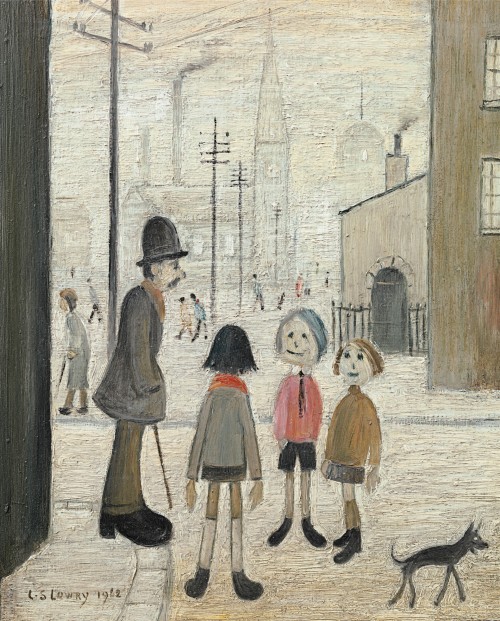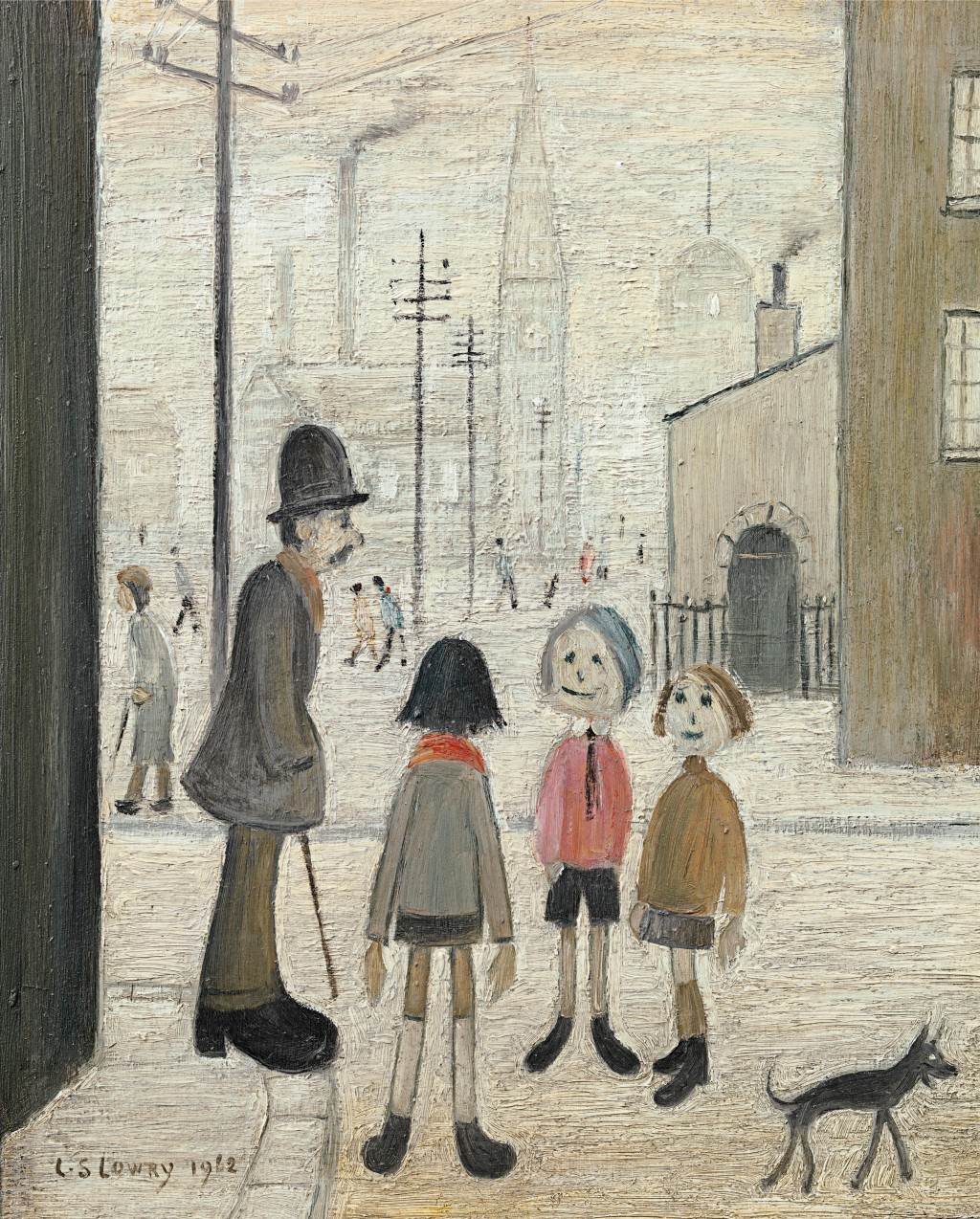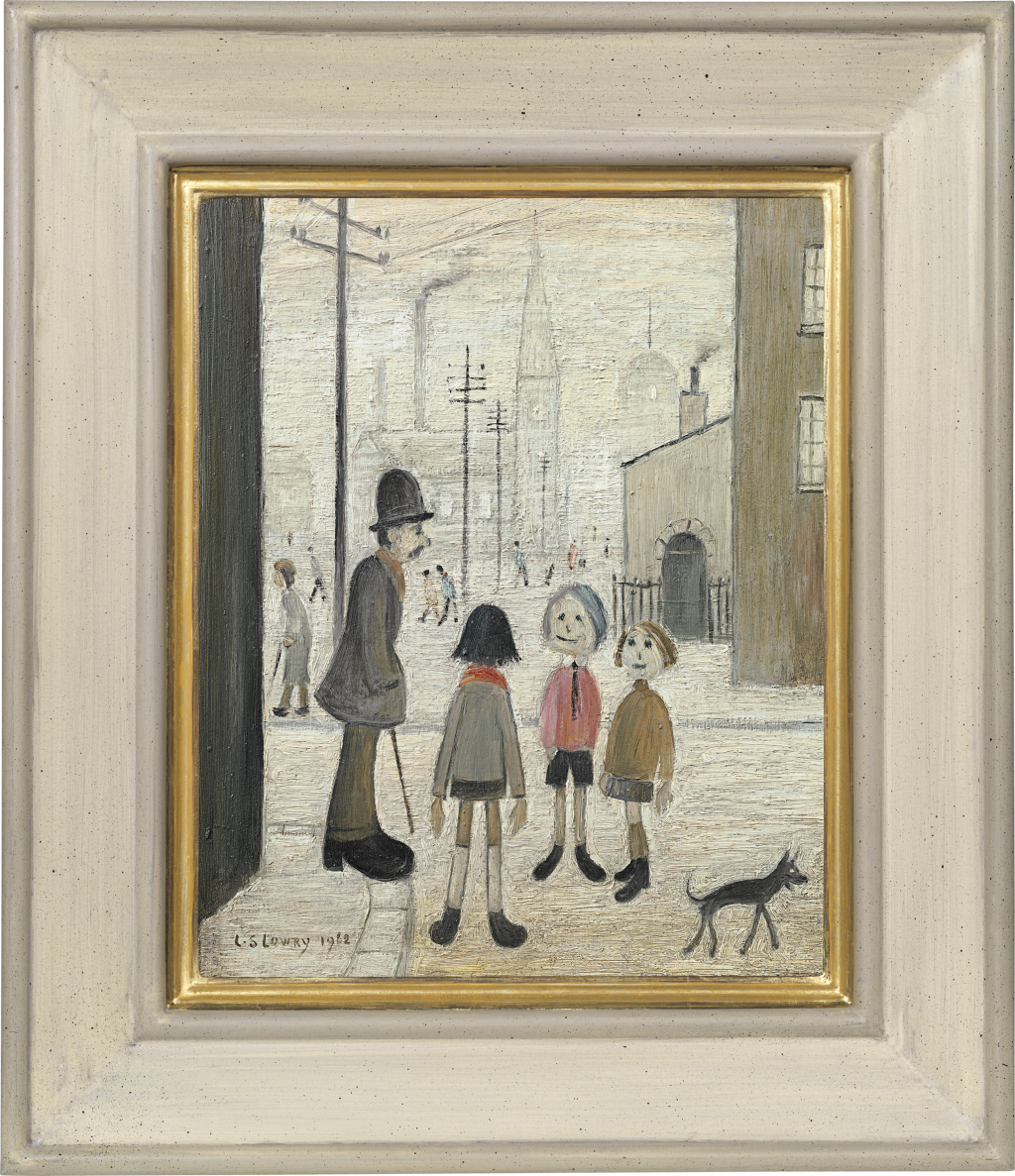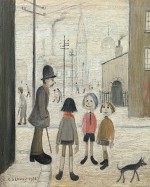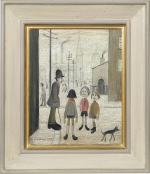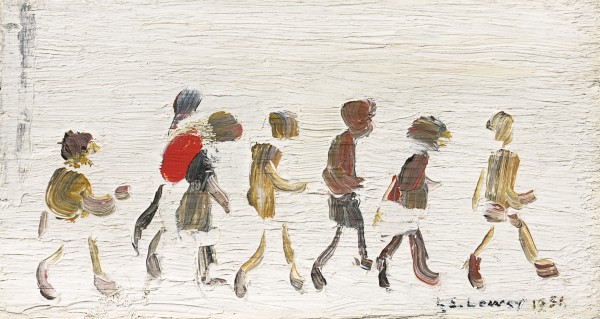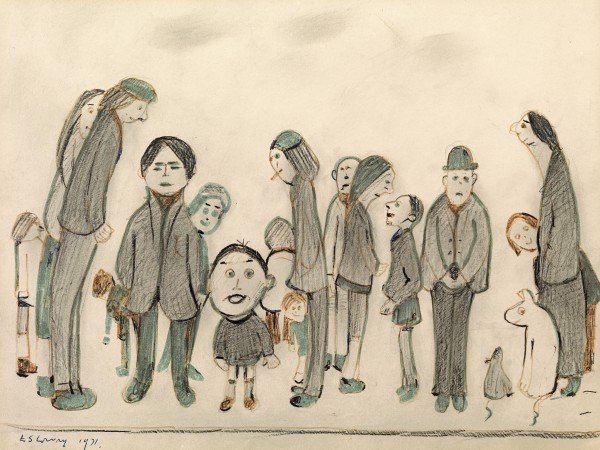LAURENCE STEPHEN LOWRY RA RBA LG NS
Manchester 1887 - 1976 Glossop
Ref: CC 130
A street
Signed and dated lower left: L.S LOWRY 1962; signed and inscribed on the reverse: LS Lowry / A Street
Oil on panel: 10 ⅞ x 8 ¾ in / 27.6 x 22.2 cm
Frame size: 15 ¾ x 13 ¾ in / 40 x 34.9 cm
Provenance:
Crane Kalman Gallery, London
Private collection
Christie’s London, 12th June 1987, lot 302
Private collection, UK, then by descent
Exhibited:
Sunderland Museum & Winter Gardens, from 1990, on loan from a private collection
Literature:
Juliet Horsley, LS Lowry in the North East, Tyne & Wear Archives & Museums 2010, p.9, illus. in colour fig.9, as Street scene
As the industrial metropolis that was Manchester and Salford began to decay by the middle of the 20th century, to be replaced by new housing and industrial units, Lowry moved from the teeming street scenes that had dominated his vision through the 1920s and 1930s to concentrate on the groups of people who were born, lived and died within the confines of the city. As he commented in an interview with Gerald Cotton and Frank Mullineux, ‘the strange thing is that when the industrial scene passed out in reality, it passed out of my mind.’[1] Throughout the 1950s and 60s, Lowry’s street scenes became composites of the best-loved areas of the city, recalled from his rent collecting days, celebrating the life of a tight-knit community. In the present work, a smart group of four stand together on the corner of a street, a classic Lowry figure with bowler hat, big boots and cane with three cheerful children and a smiling dog neatly framed by their urban environment. On the left, the cropped corner of a building projects into the space, its dark vertical emphasis echoed through a series of telegraph poles which lead the eye into the distance and the pale silhouettes of a church and smoking chimneys. The warm, soft palette of brown, grey, pink and cream give the scene a wonderful sense of nostalgia.
Lowry placed great importance on the relationship between architecture and the people in his paintings. During an interview Lowry once said, ‘The buildings were there and I was fascinated by the buildings. I had never seen anything like them before, but I was fascinated by the people who lived and worked in them. A country landscape is fine without people, but an industrial set without people is an empty shell. A street is not a street without people…it is as dead as mutton. It had to be a combination of the two - the mills and the people – and the composition was incidental to the people. I intend the railways, the factories, the mills to be a background…’[2]
LAURENCE STEPHEN LOWRY RA RBA LG NS
Manchester 1887 - 1976 Glossop
Sir Hugh Casson, in his preface to the 1976 Royal Academy Memorial exhibition, referred to LS Lowry as ‘one of the great English painters of this century.’ An individual artist with a unique style, Lowry’s work spans the first half of the twentieth century, recording with sensitivity and wit his own personal view of the people and architecture of the industrial north.
Born in Manchester in 1887, Laurence Stephen Lowry was the only child of Robert and Elizabeth Lowry. He started drawing at the age of eight and in 1903 began private painting classes which marked the start of a part-time education in art that was to continue for twenty years. In 1904, aged 16, he left school and secured a job as a clerk in a chartered accountants’ firm; he remained in full-time employment until his retirement at the age of 65. His desire to be considered a serious artist led him to keep his professional and artistic life completely separate and it was not disclosed until after his death that he had worked for most of his life.
Lowry’s early training was at the Municipal College of Art, Manchester. There he was taught by the French artist Adolphe Valette who introduced him to Impressionism and of whom he said: ‘I owe so much to him for it was he who first showed me good drawings by the great masters…he gave me the feeling that life drawing was a very wonderful thing.’ Lowry was, however, unaffected by Valette’s impressionist technique and continued to develop a more realistic approach to his art.
In 1909 Lowry and his parents moved to Pendlebury, where initially he was not happy, and for some years ignored his surroundings. In 1916, whilst waiting for a train, he became fascinated by the workers leaving the Acme Spinning Company Mill; the combination of the people and the surroundings was a revelation to him and marked the turning point in his artistic career. He now began to explore the industrial areas of South Lancashire and discovered a wealth of inspiration, remarking ‘My subjects were all around me…in those days there were mills and collieries all around Pendlebury. The people who work there were passing morning and night. All my material was on my doorstep.’
By 1920 Lowry’s street scenes, peopled with workers, housewives and children set against a backdrop of industrial buildings and terraced houses, had become central to his highly personal style. From now on he painted entirely from experience and believed that you should ‘paint the place you know.’ His leisure time was spent walking the streets of Manchester and Salford making pencil sketches on scraps of paper and the backs of used envelopes, recording anything that could be used in his work. In his early factory scenes the emphasis is placed on the buildings and the atmosphere was often dark and sombre; however, as he developed this theme the figures became more prominent and eventually he arrived at a marriage between the two where the figures and surroundings form a whole.
By the 1930s Lowry had established his own particular style. He was encouraged by his teacher Bernard Taylor to try to make his figures and buildings stand out more and he began to experiment with setting them against a white background. He chose ‘flake white,’ building up layer after layer on the canvas before painting the subject matter straight on top. He used only four other colours: vermilion, Prussian blue, ivory black and ochre, which he applied straight from the tube.
With the onset of the modernisation of the industrial north in the mid-1950s Lowry lost interest in his surroundings and now concentrated almost entirely on figures silhouetted against a white background, occasionally standing on a hint of a pavement or near a ghost of a wall, but frequently suspended in time and space. He continued to sketch and closely observe his subjects and his works from this period capture the essence of Northern people; he frequently mixes young and old and he imparts to each figure an individual character. Shelley Rohde in A Private View of LS Lowry comments: ‘he had a new obsession, his single figures, his grotesques. The struggling, surging, misshapen homunculi who used to live for so long in the shadow of the mills emerging at last from their background to stand alone, as he stood alone’.
Visits to Wales in the 1960s with his friend and patron Monty Bloom briefly revived Lowry’s interest in industrial scenes. He was impressed by the contrast between the industrial towns and the surrounding countryside; consequently his paintings from this period are brighter than his Lancashire paintings. However, towards the end of the 1960s Lowry began to lose his creative urge and, with the exception of the occasional moment of artistic inspiration, he ceased painting almost entirely.
Laurence Stephen Lowry died of pneumonia in 1976, aged 88. Although he had received critical acclaim for his work during the second half of his life, he never forgot the lack of recognition that he had received initially and he carried with him the feeling of isolation and rejection throughout his career. He refused the offer of a knighthood, as well as numerous other honours, and remained disillusioned with the art world despite the praise that was heaped upon him.
Lowry is remembered as a man of remarkable resilience and sensitivity; he stood alone, unaffected by the influences of other artists and his inspiration came entirely from his own experience. His paintings and drawings are now included in most important private and public collections in the United Kingdom and abroad and his unique works continue to receive the critical acclaim that he so richly deserves.
[1] Judith Sandling and Michael Leber, LS Lowry - The Man and his Art, City of Salford Art Gallery 1996, p.19.
[2] Judith Sandling and Michael Leber, Lowry’s City: A Painter and His Locale, Lowry Press, Salford 2000, p.17.

